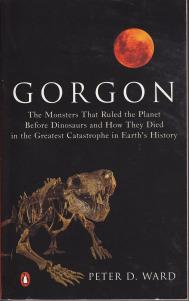 It looked like an arm bone to me. Then again, I have no formal training in either anatomy or geology. The strata of Pennsylvania shale was littered with shell fossils from before the dinosaur era. Had I found a rare early animal? You see, I love fossils. In fact, I was so disappointed the first time I walked into a Fossil store that I’ve never had the heart to go back. Something about finding the remains of creatures millions of years old is inherently fascinating, and I was fortunate enough to grow up by a river that had plenty of fossils for the taking (a great pass-time for children of humble means). When I saw Peter D. Ward’s Gorgon at a local book sale, I had to get it. In addition to my love of fossils, I also have a special interest in Medusa, and the title grabbed two aspects of my attention at once.
It looked like an arm bone to me. Then again, I have no formal training in either anatomy or geology. The strata of Pennsylvania shale was littered with shell fossils from before the dinosaur era. Had I found a rare early animal? You see, I love fossils. In fact, I was so disappointed the first time I walked into a Fossil store that I’ve never had the heart to go back. Something about finding the remains of creatures millions of years old is inherently fascinating, and I was fortunate enough to grow up by a river that had plenty of fossils for the taking (a great pass-time for children of humble means). When I saw Peter D. Ward’s Gorgon at a local book sale, I had to get it. In addition to my love of fossils, I also have a special interest in Medusa, and the title grabbed two aspects of my attention at once.
The gorgon of the title is explained by the subtitle: The Monsters That Ruled the Planet Before Dinosaurs and How They Died in the Greatest Catastrophe in Earth’s History. As Ward explains, many in the media express surprise that there was anything before the dinosaurs. Perhaps I grew up with too much Genesis on the mind, but I knew about the Permian Extinction—the most deadly episode in Earth’s biological history. Over 90 percent of life forms died out, including some of the cooler species of mammal-like reptiles like the dimetrodon. I have to confess, however, that I don’t recall ever hearing about gorgons before. They are a South African species. Well, they were, long before apartheid and other ridiculous human foibles. Indeed, one of the charms of Ward’s account is that he doesn’t separate the human element from the paleontological. His visits to South Africa often demonstrated how the current dominant species of the planet participates in its own extinction. Valuing personal gain over social justice cannot have long-term payoffs.
This is a compelling story of people committed to finding answers in a barren land. To an inveterate fossil-hunter like me, it was a dreamy sort of read. I had my fossil “arm bone” assessed by a geologist. It was actually a trilobite trail. A trace fossil. Sometimes things aren’t what they seem. The answer of why of the Permian Extinction transpired turned out to be the most distressing aspect of the tale. Climate change, Ward demonstrates, can easily lead to mass extinction through the very act of breathing. Our evolution has favored the current atmospheric makeup of our planet. Dinosaurs, who appeared after the Permian Extinction, had evolved lungs for processing air with less oxygen than we’re used to. Greenhouse gases can shift subtle, invisible balances that are necessary for taking a breath. And I could extrapolate to a future where technology will again come to the rescue, but only of those who can afford it. And I wonder what far distant evolved intelligent species will make of a civilization where financial gain was considered the greater good than survival of an entire species? Humanity itself will have become a fossil by then. But a well-dressed one.
